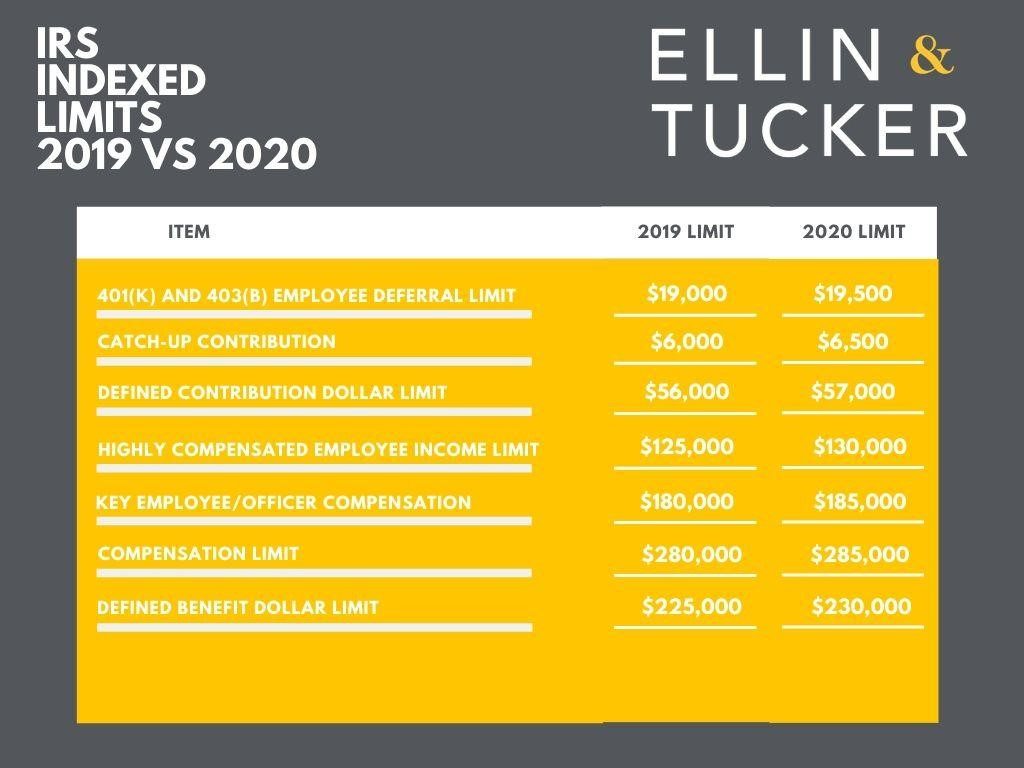The IRS Changes Bringing Smiles to Employee’s and Plan Admin’s Faces

Don’t make the mistake of glossing over the newest retirement plan rules and regulations going into effect in 2020. The IRS has recently released a variety of new standards that directly (and positively) impact qualified retirement plans, employees, and plan administrators. But administrators need to keep a close eye on these updates and employees should always be cognizant of the regulations that affect their retirement savings plans. But what exactly do you need to be aware of? First, employees will be excited to learn that new dollar limitations increased for a number of plans, giving employees the option to increase their contributions. Plan administrators will be eager to implement the new IRS adjusted hardship distribution requirements and updated regulations focused on alleviating common concerns surrounding uncashed distribution checks. Let’s dig a little deeper to better understand how the new regulations will fully impact businesses and their employees in 2020 and beyond.
New Limitations
The IRS updated a number of dollar limitations for 2020 contributions based upon the cost-of-living adjustments for the upcoming year. While most of these changes did not come as a surprise, those that increased are important to highlight. Increases that went into effect for 2020 were catch-up contributions, 401K contributions, the 401(k) and 403(b) employee deferral limit, the defined contribution maximum limit, the key employee compensation limit, the highly compensated employee income limit, and the defined benefit dollar limit.
Though IRS records indicate the majority of employees comply with annual limits, there’s always room for improvement. Plan administrators should save themselves the trouble later on and ensure the following limitation regulations are being adhered to:

Updated Hardship Distribution Regulations
You’ll find both plan administrators and plan participants a bit more at ease with the new hardship withdrawal regulations in place. Beginning in 2020, the six-month contribution suspension will be eliminated, giving participants an opportunity to continue making contributions directly following a hardship distribution. The IRS also removed the requirement that participants must first take an available loan before requesting a hardship distribution. But it should be noted that plans can still require that a loan is taken prior to a distribution, it’s just no longer a mandatory standard for all plans. Participants are also now able to have their earnings and contributions disbursed, not just the funds from their contributions, with the exception of 403(b) plans. Again, this change is optional.
Prior to these new regulations, plan administrators had to take into account, “all relevant facts and circumstances” to determine if a withdrawal was necessary. Fortunately, they can now abide by the following safe harbor financial needs test, released by the IRS, to make their decision:
Needless to say, this three-part test gives plan administrators a less ambiguous way to conclude if a hardship contribution is necessary and makes it substantially easier for employees to access these funds during their time of need.
Uncashed Distribution Checks
Previously, outstanding distribution checks were a catalyst for confusion and frustration among plan administrators. After a distribution, if a check remained uncashed, the administrator’s obligation to withhold income tax and report the distribution on the Form 1099-R, was of concern. Now if an individual fails to cash a check during the year in which it was distributed, they are still liable to include the distribution with their gross income. The plan administrator will withhold income tax from any distributions made that year and report them on the Form 1099-R, and no longer be affected by the inaction of the distribution recipients- what a relief! This ruling is only applicable to mandatory distributions and gives a concrete standard for those affected to abide by, making everyone’s roles and responsibilities clearer. However, this new regulation does not solve the most common concern involving uncashed distribution checks: “missing participants”. The IRS will continue to analyze missing participant scenarios that involve outstanding distribution checks that have not been received by the employee due to the check being sent to an incorrect mailing address.
The implementation of these new regulations will certainly reduce common obstacles faced by plan administrators and provide them with more objective guidance, while helping employees better plan for the future. Taking note of the changing contribution limitations going forward is of great importance as well, so that plan administrators will prevent future issues regarding employees exceeding their contribution limits and employees being able to adjust their maximum contribution amount. This direction from the IRS will be remarkably helpful and appreciated by plan administrators and employees alike.
As we approach 80 years, Ellin & Tucker remains firmly in the room, driven by a legacy of excellence in teamwork, leadership, and service. Our strength has always been in our people, and together, we’ll continue to stand with the next generation of difference-makers and leaders, ready to shape the future.